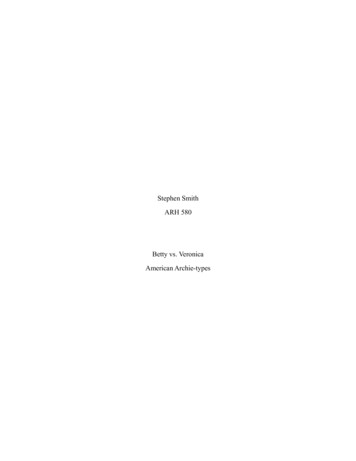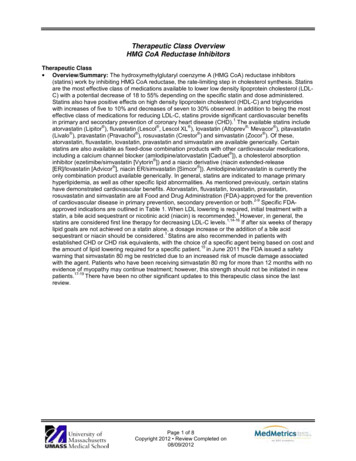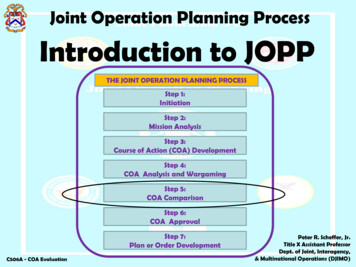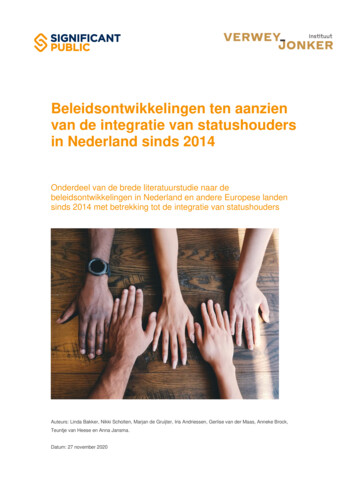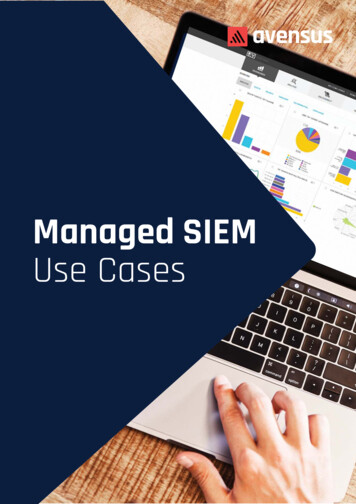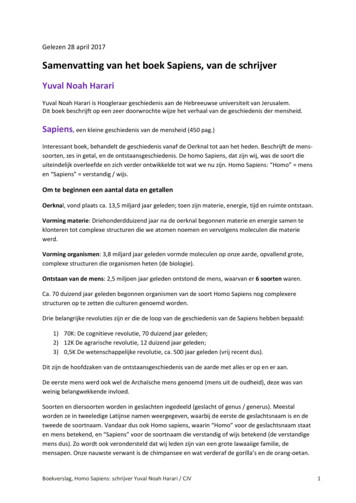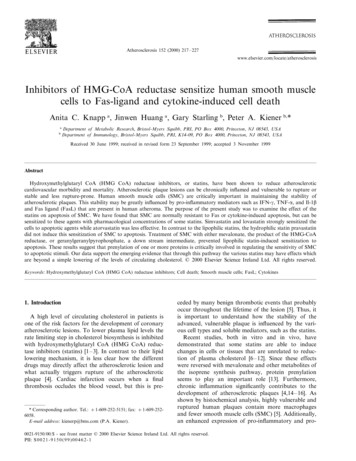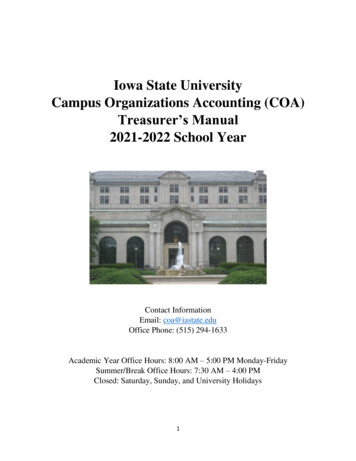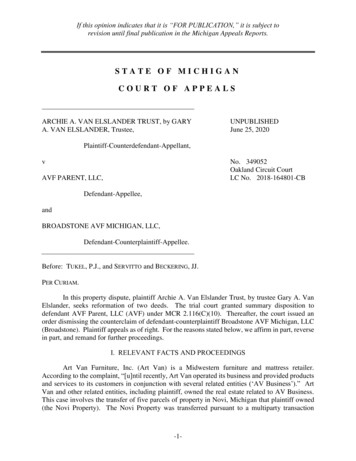
Transcription
If this opinion indicates that it is “FOR PUBLICATION,” it is subject torevision until final publication in the Michigan Appeals Reports.STATE OF MICHIGANCOURT OF APPEALSARCHIE A. VAN ELSLANDER TRUST, by GARYA. VAN ELSLANDER, Trustee,UNPUBLISHEDJune 25, 2020Plaintiff-Counterdefendant-Appellant,vNo. 349052Oakland Circuit CourtLC No. 2018-164801-CBAVF PARENT, LLC,Defendant-Appellee,andBROADSTONE AVF MICHIGAN, LLC,Defendant-Counterplaintiff-Appellee.Before: TUKEL, P.J., and SERVITTO and BECKERING, JJ.PER CURIAM.In this property dispute, plaintiff Archie A. Van Elslander Trust, by trustee Gary A. VanElslander, seeks reformation of two deeds. The trial court granted summary disposition todefendant AVF Parent, LLC (AVF) under MCR 2.116(C)(10). Thereafter, the court issued anorder dismissing the counterclaim of defendant-counterplaintiff Broadstone AVF Michigan, LLC(Broadstone). Plaintiff appeals as of right. For the reasons stated below, we affirm in part, reversein part, and remand for further proceedings.I. RELEVANT FACTS AND PROCEEDINGSArt Van Furniture, Inc. (Art Van) is a Midwestern furniture and mattress retailer.According to the complaint, “[u]ntil recently, Art Van operated its business and provided productsand services to its customers in conjunction with several related entities (‘AV Business’).” ArtVan and other related entities, including plaintiff, owned the real estate related to AV Business.This case involves the transfer of five parcels of property in Novi, Michigan that plaintiff owned(the Novi Property). The Novi Property was transferred pursuant to a multiparty transaction-1-
governed by an equity purchase agreement (“EPA”) in which AVF agreed to purchase the equityand assets of the Art Van Furniture business along with specified real property related to thebusiness. AVF and plaintiff were parties to the EPA, and Broadstone was AVF’s designee for andthe ultimate purchaser of the Novi Property.Parcels 1 through 3 of the Novi Property totaled 6.7 acres, had the street address of 27775Novi Road, Novi, Michigan, 48377, and comprised the Novi Art Van Showroom and parking lot.Behind and separate from parcels 1 through 3 were parcels 4 and 5 of the Novi Property, whichconstituted 1.41 acres, were not used in conjunction with the operations of the Novi Art VanShowroom, and did not have a street address. According to plaintiff, the parties intended thatplaintiff would sell only parcels 1 through 3 because they were used in relation to the Art Vanbusiness. The property to be sold was appraised, and the appraisal only included parcels 1 through3, showing a value of 14.9 million for the 6.7 acres that included the building and parking lot.This information was included in the marketing materials plaintiff provided to potential buyers.The parties agree that parcels 4 and 5 were not “Excluded Real Estate” as defined in theEPA and were transferred under the agreement. However, plaintiff contends that their inclusionwas a mistake. According to plaintiff, the title company, working exclusively with AVF, orderedsurveys and title work that erroneously included parcels 4 and 5; that mistake was not caught andso it continued throughout the transaction, leading to plaintiff’s inadvertent transfer of parcels 4and 5. In March 2018, this lawsuit was filed against defendants seeking reformation of the deedsthat plaintiff executed for the Novi Property on the basis of mutual mistake. Unilateral mistakewas alleged in the alternative. Under the terms of the equity purchase agreement, Delaware lawcontrolled the case.AVF moved for summary disposition under MCR 2.116(C)(8) (failure to state a claim) andMCR 2.116(C)(10) (no genuine issue of material fact), contending that AVF and Broadstone werenot mistaken and that they had intended to and did purchase all five parcels. AVF further arguedthat plaintiff could not show that the covenant and quitclaim deeds were contrary to the equitypurchase agreement, which was fatal to plaintiff’s claim, and that even if plaintiff could establishthat the covenant and quitclaim deeds were contrary to the equity purchase agreement, plaintiff’s“repeated and unreasonable failure to discover its mistake constitutes a failure to abide byappropriate standards of good faith and fair dealing.” Plaintiff responded that the deeds did notexpress the intention and agreement of the parties because only real property used by Art Van wasintended to be conveyed in the transaction. Plaintiff attached various photographs of the parcelsand marketing materials dated October 2016 that related to the Novi Property.The trial court held a hearing on AVF’s motion for summary disposition. After briefargument by the parties, the trial court concluded that plaintiff had stated a claim upon which reliefcould be granted for reformation on the basis of mutual or unilateral mistake under Delaware lawand denied summary disposition under (C)(8) on that basis. The trial court then considered AVF’sargument under (C)(10) that plaintiff had failed to establish mutual or unilateral mistake and thatplaintiff’s own negligence barred the relief plaintiff sought. The trial court concluded that althoughplaintiff had argued that a question of fact existed regarding its fault, plaintiff had failed to addressthe three elements it had to satisfy and had attached no evidence in support of its position; rather,plaintiff relied solely on the allegations contained in its amended complaint, along with aerialphotographs of the disputed parcels and copies of marketing materials for the Novi Art Van-2-
Showroom, which were insufficient to raise a genuine issue of material fact. Accordingly, the trialcourt granted summary disposition under (C)(10) and entered an order dismissing plaintiff’s claimbut noting that Broadstone’s countercomplaint remained pending.Broadstone moved for entry of dismissal of its countercomplaint without prejudice and,receiving no objection from plaintiff, the trial court granted the motion and issued a final orderclosing the case. Plaintiff filed a motion for reconsideration alleging, among other things, thatsummary disposition under (C)(10) was premature because discovery was not closed and AVF hadfailed to meet its initial burden to support its position that plaintiff had failed to act in good faith.The trial court denied the motion, concluding that plaintiff failed to demonstrate palpable error.Plaintiff now appeals.II. DISCUSSIONA. STANDARD OF REVIEWThis Court reviews de novo a trial court’s decision to grant summary disposition. BarnardMfg Co, Inc v Gates Performance Engineering, Inc, 285 Mich App 362, 369; 775 NW2d 618(2009). Any evidence is viewed in the light most favorable to the nonmoving party. Moraccini vCity of Sterling Heights, 296 Mich App 387, 391; 822 NW2d 799 (2012). Summary dispositionunder MCR 2.116(C)(10) is appropriate if there is no genuine issue of material fact except aboutthe amount of damages, and the moving party is entitled to judgment as a matter of law. RoyalProp Group, LLC v Prime Ins Syndicate, Inc, 267 Mich App 708, 713; 706 NW2d 426 (2005). Agenuine issue of material fact exists if, giving the benefit of reasonable doubt to the nonmovingparty, the record leaves open an issue on which reasonable minds could differ. Id.B. MCR 2.116(C)(10)Plaintiff asserts that the trial court erred by granting AVF’s motion for summary dispositionpursuant to MCR 2.116(C)(10). Plaintiff contends that AVF failed to meet its burden to show thatthere was no genuine issue of material fact as to its affirmative defense. Plaintiff further contendsthat even if AVF had met its burden, proper analysis of the present case under the standards setforth in Scion Breckinridge Managing Member, LLC v ASB Allegiance Real Estate Fund, 68 A3d665, 676-677 (Del, 2013), demonstrates that there remain questions of fact as to whether plaintiff’salleged negligence was so extreme as to bar reformation. We agree.Pursuant to the choice-of-law provision in the equity purchase agreement, Delaware lawcontrols whether plaintiff properly alleged a claim for deed reformation on the basis of unilateralor mutual mistake and whether AVF established its affirmative defense that plaintiff’s negligencebarred reformation. Under Delaware law,[t]here are two doctrines that allow reformation. The first is the doctrine ofmutual mistake. In such a case, the plaintiff must show that both parties weremistaken as to a material portion of the written agreement. The second is thedoctrine of unilateral mistake. The party asserting this doctrine must show that itwas mistaken and that the other party knew of the mistake but remained silent.Regardless of which doctrine is used, the plaintiff must show by clear and-3-
convincing evidence that the parties came to a specific prior understanding thatdiffered materially from the written agreement. [Cerberus Int’l, Ltd v Apollo Mgt,LP, 794 A2d 1141, 1151-1152 (Del, 2002).]“Reformation is not precluded by the mere fact that the party who seeks it failed to exercisereasonable care in reading the writing[.]” Restatement (Second) of Contracts § 155, cmt a (1981).As the Delaware Supreme Court has noted, “[a]ny mistake claim by definition involves a partywho has not read, or thought about, the provisions in a contract carefully enough.” Cerberus, 794A3d at 1154. Nevertheless, in extreme cases, negligence will bar reformation, and the DelawareCourt has expressly adopted the following standard from the Restatement (Second) of Contracts,§ 157:[F]or purposes of a reformation claim: “[a] mistaken party’s fault in failing to knowor discover the facts before making the contract” does not bar a reformation claim“unless his fault amounts to a failure to act in good faith and in accordance withreasonable standards of fair dealing.” To the extent existing Delaware case law isinconsistent with this standard, we expressly overrule it. [Scion, 68 A3d at 676677 (Del, 2013).]Scion illustrates the Delaware court’s application of the Restatement standard. Thepertinent question in Scion was whether the plaintiff, ASB Allegiance Real Estate Fund (“ASB”)was entitled to reformation of three joint-venture agreements entered into with the defendant,Scion Breckinridge Managing Member, LLC (“Scion”).1 ASB is an investment advisor forpension funds, and “[b]etween January 2007 and January 2008, ASB-advised pension fundsentered into five joint ventures for the ownership, operation, and development of student housingprojects.” Id. at 669. Although ASB’s president, Robert Bellinger, did not personally negotiatethe ventures, he “actively oversaw the negotiations and personally approved each venture.” Id.The court explained the basic framework for a real estate joint venture project as follows:[A] promoter provides the bulk of the capital and a sponsor arranges the deal andmanages the property. ASB served as the promoter in each of the five ASB–Scionjoint ventures, providing at least 99% of the capital and retaining at least 99% ofthe equity. Scion served as the sponsor and invested no more than 1% of the capital.Scion earned a management fee for overseeing the project’s day-to-day operations,as well as a leasing fee and an acquisition fee. Scion primarily earned itscompensation, however, through an incentive payment known as a “promote.”Generally, a promote is triggered once the project generates a specifiedpreferred return on the invested capital. Once the project achieves the specifiedpreferred return, the promote rewards the sponsor with a greater proportion of the1Captions for the opinions of the Delaware Supreme Court name the party-appellant first,regardless of whether that party was the plaintiff or the defendant in the lower court proceedings.Thus, in the case of Scion, Scion is the “Defendant below Appellant” and ASB the “Plaintiff belowAppellee.”-4-
project’s profits. Real estate professionals commonly discuss promotes usingindustry shorthand, in which they describe the economics as “an X over a Y.” Forexample, the phrase “20% over an 8%” means the sponsor would receive 20% ofincremental profits after the project generated an 8% preferred return. [Id. at 670.]ASB used the law firm, DLA Piper, LLC, as outside counsel, and DLA Piper partnerBarbara Trachtenberg drafted and negotiated the parties’ agreement for the first joint venture (“thefirst agreement”). Id. The first agreement incorporated the parties’ agreed-upon promote andpreferred return terms in a “waterfall” provision. The effect of the provision was that “the partieswould receive distributions in proportion to their respective percentage equity investments,approximately 99% for ASB and 1% for Scion,” until each party received an amount equal to thepreferred 8% return on their respective investment and recovered its initial capital investment. Id.at 671. Only after ASB had recovered its initial capital investment “would Scion receive a promotepayment equal to 20% of the excess profits, with ASB and Scion splitting the remaining 80%according to their 99:1 equity ratio.” Id. at 671. The record established that Bellinger read thefirst agreement in its entirety and was familiar with its terms. See id. at 677-678. Subsequently,Trachtenberg handed over most of the drafting responsibilities to Cara Nelson, a junior associateat DLA Piper with only a few months’ experience working on real estate joint venture deals. Id.at 670.The first agreement served as the template for the agreement for the second joint venture(“the second agreement”). But between the second agreement and drafting of the agreement forthe third joint venture project (“the third agreement”), Scion co-founder Rob Bronstein and ASBpresident Bellinger negotiated a change in terms, reaching an agreement in May 2007 that resultedin a two-tiered promote structure that would allow Scion to earn more money if it increased annualprofits through successful property management. Id. at 671. According to the May 2007 terms,after annual returns had reached the initial preferred return amount and the parties had recoveredtheir capital, Scion would receive 20% of the profits and split the remaining 80% of the profitswith ASB according to their equity ratio. Should the annual return reach a specified higherpercentage, Scion would get 35% of the profits and split the remaining 65% of the profits withASB according to their equity ratio. Id.DLA Piper attorney Nelson used the second agreement as the template for the thirdagreement and revised it in accordance with her understanding of the terms of the May 2007agreement. But in drafting the third agreement, Nelson placed the first-tier promote after the firstpreferred return instead of after both parties recovered their capital investment. The economiceffect of this reversal was that after the parties reached their first preferred return, Scion received20% of every dollar of ASB’s initial investment. Trachtenberg testified that she could notremember whether she read the drafts of the third agreement before Nelson circulated them, butsurmised that if she had, she had not focused on the waterfall provision because the error wasegregious and she would have noticed it immediately. See id. Bellinger testified that he reviewedparts of the third agreement, but admitted that he failed to read it carefully, and “[t]he ASBInvestment Committee approved the deal based on an internal memorandum describing the-5-
Waterfall as consistent with the May 2007 Terms.”2 Id. Nelson drafted agreements for the fourthand fifth projects (“the fourth agreement” and “the fifth agreement” respectively) by electronicallycopying the third agreement and making minor, deal-specific changes. Bellinger and Trachtenbergtestified that they did not read the agreements carefully, and the ASB Investment Committeeapproved the deals based on internal memoranda. Id. at 673-674. Both agreements had waterfallprovisions that placed the first-tier promote ahead of the return of capital investment. Id.The error came to light when Scion exercised its put rights in the fourth and fifthagreements, demanding put purchase prices that included promote payments totaling 4.1 million.Thus, as a result of the drafting error, Scion claimed a profit of more than 2.8 million (223%) ontheir initial capital investments before ASB had recovered its capital investment. See id. at 674675. After discovering the drafting error in the third through fifth agreements, ASB filed suit inDelaware’s court of chancery seeking reformation of the three improperly drafted agreements.The action proceeded to trial. The chancery court found that the first agreement served asthe basis for the disputed agreements and that Bellinger had read the first agreement completely,after which he relied on his attorneys and ASB’s liaison with Scion to “advise him about anychanges, brief him on new terms, and provide him with any portions that he needed to read.” Idat 675-676. The chancery court concluded, therefore, that “Bellinger adequately and properlyoversaw the negotiation process and was informed about the terms of the joint venture agreementsas negotiated by the parties.” The chancery court ruled that “even assuming Bellinger read noneof the Disputed Agreements, but rather relied on his employees and advisors to inform him of anychanges, his failure to read would not bar a reformation claim.” Id. at 676. Accordingly, the courtreformed the disputed agreements in ASB’s favor.Scion appealed in the Delaware Supreme Court, arguing that Delaware law did not supportthe chancery court’s ruling. The Supreme Court took the opportunity to clarify Delaware lawregarding when a party’s conduct is so negligent as to bar reformation by adopting Restatement, §157. Applying the restatement standard tot the facts before it, the Court explained:[T]he Restatement indicates that parties’ conduct does not amount to a failure toact in good faith and in accordance with reasonable standards of fair dealing where(1) one party’s lawyer erroneously reduced the parties’ actual agreement to writing,(2) neither party read the writing before signing it, and (3) the error would havebeen obvious had the parties read the writing. See Restatement (Second) ofContracts §§ 155 cmt a, illus 1, 157 cmt b, illus 3 (1981). [Scion, 68 A3d at 678 n41.]ASB’s attorney erroneously reduced the terms of the parties’ May 2007 agreement towriting in the third agreement and perpetuated the error in the fourth and fifth agreements, and hererror was obvious to Trachtenberg and to Bellinger upon reading the disputed agreements.2Eric Bronstein, the other co-founder of Scion, read the draft, realized the advantage the placementof the terms gave Scion, and said nothing. Id. at 672. This was the basis of the chancery court’sfinding of unilateral mistake. See id. at 678.-6-
Although Bellinger admitted that he did not carefully read the third, fourth, or fifth agreementsbefore executing them, the Supreme Court approved of the chancery court’s conclusion thatDelaware law does not “require that a senior decision-maker like Bellinger read every word ofevery agreement.” Id. at 678 (quotation marks omitted). Thus, the Court held “that even assumingBellinger did not read the Disputed Agreements, he acted in good faith and in accordance withreasonable standards of fair dealing.” Id. at 677.Turning to the case at bar, plaintiff contends that AVF failed to meet its initial burden toshow that there are no genuine issues of material fact as to its affirmative defense that plaintiff’sown negligence bars its claim of reformation. We agree. AVF points to a multitude of title-relateddocuments that attorneys for plaintiff requested, reviewed, revised, or approved. These explicitlyincluded parcels 4 and 5 as part of the Novi property. From these, AVF infers that the partiesintended parcels 4 and 5 to be included on the disputed deeds, or if the parties did not so intend,then the failure of plaintiff’s attorneys to detect and correct the alleged error before incorporatingit into the deeds constitutes a failure to act in accordance with reasonable standards of fair dealing.However, this argument is similar to saying that since the DLA Piper attorney who incorporatedher erroneous understanding of the terms of the May 2007 agreement between ASB and Scion intothe third agreement, and then perpetuated the error by incorporating it into the fourth and fifthagreements, that either the parties intended the effects of the error, or ASB’s failure to catch andcorrect the error was negligence of such magnitude as to bar reformation of the disputedagreements. Here, as in Scion, AVF cannot point to the perpetuation of an alleged mistake asevidence of intent or, without more, of negligence on the part of plaintiff so extreme as to barreformation. The Scion Court looked to facts and circumstances of Bellinger’s conduct indetermining whether failure to catch and correct the attorney’s error met the Restatement’sstandard of negligence that amounted to a “failure to act in good faith in accordance withreasonable standards of fair dealing.” Viewing the evidence in the light most favorable to plaintiff,AVF presented ample evidence of the actions of plaintiff’s attorneys, but none of plaintiff’sconduct. Absent such evidence, AVF has not met its initial burden to show that no genuine issueof material fact exists that plaintiff’s conduct was so extreme as to bar reformation.Even if we assumed for the sake of argument that AVF had met its initial burden, we alsoagree with plaintiff that the application of the Restatement standard, as illustrated in Scion, weighsagainst granting AVF’s motion for summary disposition on the basis of its affirmative defense.The Scion Court’s application of the Restatement’s standard indicated that the degree of negligencerequired to bar reformation is not shown where “(1) one party’s lawyer erroneously reduced theparties’ actual agreement to writing, (2) neither party read the writing before signing it, and (3) theerror would have been obvious had the parties read the writing.” Scion, 68 A3d at 678 n 41.Applying these criteria to the facts of the present case, it is undisputed that, just as ASB’sattorney drafted the disputed agreements for which ASB sought reformation, the present plaintiff’sattorneys drafted the disputed deeds for which plaintiff now seeks reformation. However, AVFargues that plaintiff has presented no evidence of a prior agreement that excluded parcels 4 and 5from transfer and, therefore, that the text of the disputed deeds accurately represents the parties’“actual agreement.” Although AVF raised the issue of whether plaintiff presented evidence of aspecific prior agreement in its summary disposition brief, the trial court did not rule on it.Reviewing the record de novo, we are convinced that there is evidence from which a rational trier-7-
of fact could infer that plaintiff could prove the existence of a specific prior agreement by clearand convincing evidence. See Cerberus, 794 A2d at 1149.Plaintiff attached to its response to AVF’s motion for summary disposition pages from amarketing brochure sent to potential buyers that described the Novi property as located at 27775Novi Road, Novi, Michigan, 48377, and consisting of 6.7 acres. AVF has not disputed that thisdescribed parcels 1 through 3. Viewing this evidence in the light most favorable to plaintiff, thebrochure indicates plaintiff’s intent to sell Novi property consisting only of parcels 1 through 3.In addition, various provisions of the EPA also suggest that plaintiff intended to sell, and AVF topurchase, the Novi property presented in the marketing brochure, i.e., parcels 1 through 3.According to the EPA, one of plaintiff’s responsibilities at closing was to deliver to thebuyer deeds conveying the “specified owned real property.” EPA § 6.1(d)(i). Section 2.1(b) ofthe EPA defines “specified owned real property” as “Real Property owned by the Real PropertyTransferors.” Elsewhere, the EPA defines “real property” as “the Owned Real Property and theLeased Real Property.” EPA, p 15. Neither party claims that the Novi property falls into thecategory of “leased real property,” or that parcels 4 and 5 of that property are on the schedule thatlists leased real property. Therefore, it is reasonable to assume that the Novi property falls intothe category of “owned real property.” “Owned Real Property” is listed on Schedule 4.7(a), which“sets forth the street address of each parcel of Owned Real Property and the owner thereof.” EPA§ 4.7(a). AVF does not dispute that parcels 4 and 5 do not have a street address and are not listedon Schedule 4.7(a).3 If Schedule 4.7(a) lists the owned real property to be transferred, and parcels4 and 5 are not included on this list, just as they are not included in plaintiff’s marketing materials,then, viewing the evidence in the light most favorable to plaintiff, a rational trier of fact could inferthat plaintiff has shown clear and convincing evidence of a prior agreement that did not includethe transfer of parcels 4 and 5. Accordingly, by including parcels 4 and 5 in the disputed deeds,plaintiff’s attorneys “erroneously reduced the parties’ actual agreement to writing.” Scion, 68 A3dat 678 n 41.With regard to the second criterion, the record is silent as to whether plaintiff read the deedsin their entirety before their delivery. The Delaware Supreme Court has noted that “although [aplaintiff’s] failure to read the contract is not itself dispositive of [the plaintiff’s] reformation claim,that failure to read nevertheless substantially compromises the claim that the contract as writtendiffered from what the parties had agreed upon.” Parke v Bancorp Inc v 659 Chestnut LLC, 217A3d 701 (Del, 2019). AVF contends that failure to notice that parcels 4 and 5 “were included inevery single relevant transactional document” makes plaintiff’s claim of a mistake unlikely and“substantially compromises” its claim that the disputed deeds are different from what the partieshad agreed upon. However, Schedule 4.7(a) appears to us to be a “relevant transactionaldocument” of particular significance, since it lists the “owned real property” subject to transfer3Instead, AVF points to EPA § 5.19(b), which states that the buyer had arranged a land survey ofthe “owned real property,” and then to the survey itself, which includes parcels 4 and 5 in its surveyof the Novi property. However, this is the alleged mistake that plaintiff contends resulted in theerroneous drafting of the disputed deeds.-8-
and for which title work is required, and AVF does not dispute that parcels 4 and 5 were not onthat schedule.Further, even if we assume with AVF that plaintiff did not read the deeds before they weredelivered, whether that omission signifies a “failure to act in good faith and in accordance withreasonable standards of fair dealing” arguably depends on the circumstances. As previouslyindicated, the Delaware Supreme Court held in Scion that, even if Bellinger did not read thedisputed agreements, “he acted in good faith and in accordance with reasonable standards of fairdealing.” Scion, 68 A3d at 677. That holding rested in part on the record support for the chancerycourt’s factual finding that Bellinger had read the first agreement in its entirety, that the firstagreement was the basis of the disputed agreements, and that he had relied on his advisors toinform him of any matters relevant to the latter agreements. The Court did not address “whetherBellinger would have satisfied the Restatement standard if he had failed to read the firstagreement.” Id. at 678 n 41. The Scion court’s ruling signifies that whether conduct violates goodfaith and reasonable standards of fair dealing depends on an analysis of the factual context of theconduct. Underlying the case at bar is a complex transaction, conducted over the course of onlysix months, involving hundreds of millions of dollars in assets at 41 separate properties and whoknows how many lawyers, and resulting in a written agreement (the EPA) in excess of 100 pages,not counting attached documents. It seems to us that rational jurors could disagree regardingwhether plaintiff’s reliance on its advisors and presumed failure to read the disputed deeds was,under the circumstances, negligence of such a magnitude as to constitute a “failure to act in goodfaith or in accordance with reasonable standards of fair dealing.”Regarding the third criterion, it seems reasonable to assume that the alleged error wouldhave been obvious had plaintiff read the disputed deeds. Viewing the evidence in the light mostfavorable to plaintiff, its marketing materials indicated that they were offering to sell the threeparcels at 27775 Novi Road, this was the property listed on the schedule of owned real property,and that the three parcels were the only property that should have been conveyed by the disputeddeeds, but for their attorneys’ alleged erroneous reduction of the parties’ agreement to writing. Tothe extent that AVF argues that there was no mistake, that is a matter to be resolved through furtherproceedings.We conclude that the trial court erred in granting AVF’s motion for summary dispositionpursuant to MCR 2.116(C)(10). Because AVF failed to present any evidence of plaintiff’s conductto establish that there were no genuine issues of material fact that plaintiff’s negligence barredreformation, AVF failed to met its initial burden. And even if it had met its initial burden, analysisof the record through the lens of Scion raises genuine issues of material fact as to whetherplaintiff’s assumed conduct of not reading the disputed documents constitutes a failure to act ingood faith and in accordance with reasonable standards of fair dealing. This is not to say thatplaintiff will ultimately prevail or that AVF cannot support its affirmative defense. It merelyrecognizes that, given the anemic state of discovery, summary disposition was premature.Lastly, A
and assets of the Art Van Furniture business along with specified real property related to the business. AVF and plaintiff were parties to the EPA, and Broadstone was AVF's designee for and the ultimate purchaser of the Novi Property. Parcels 1 through 3 of the Novi Property totaled 6.7 acres, had the street address of 27775


